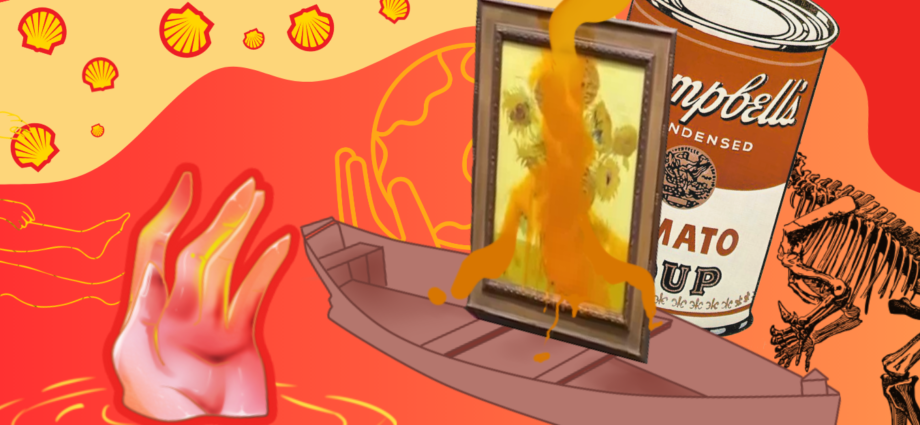Written by Aiyana Vittoria Amplatz
The call for action towards the mitigation of climate change has increased its urgency as a growing number of territories remain affected by its destructive consequences in the form of droughts, floods, bushfires, and epidemics. The most recent instance saw people struggling to repair what was damaged by the disastrous floods affecting around 40 towns in the Italian region of Emilia-Romagna killing 15 people and leaving another 200,000 homeless. As a reaction to the aggravating environmental situation, the past two years have seen a drastic change in environmental activism. Leading environmental organisations Extinction Rebellion, Last Renewal, Just Stop Oil, and Ultima Generazione (“Last Generation”) have shifted their attention from attacking pipelines to targeting artworks and historic sites. Environmental movements have tried many ways to raise awareness of the problem, but this approach has been the most effective in capturing public attention.
Environmental organisations began to target artworks in the summer of 2022 when Utima Generazione activists glued themselves to Botticelli’s Primavera (1480) on June 22 in the Gallerie degli Uffizi in Florence. This was followed by Just Stop Oil activists glueing themselves to Horatio McCulloch’s My Heart’s in the Highlands (1860) on June 29 at the Kelvingrove Art Gallery and Museum in Glasgow. Art-targeting activism quickly expanded to the rest of Europe targeting among others the Mona Lisa (1503) in the Louvre in Paris. It then started being adopted in countries outside of Europe such as Australia where activists spraypainted the Woodside (energy company) logo on McCubbin’s Down on his luck (1889). Art-targeting activism includes actions that range from activists glueing themselves to the frames of artworks, historical displays – such as the case of two activists glueing themselves to a dinosaur display in Berlin – and statues, sloshing different types of liquids on paintings’ protective glasses, and dumping liquids into fountains such as the Spanish Steps and the Trevi fountains in Rome.
Art-targeting activism has successfully garnered public attention nevertheless fostering mixed reactions. On the one hand, there are individuals who support non-violent civil disobedience and stand alongside activists to fight for their cause, on the other hand, others critique these activists, often labelling them as vandals. It is necessary, therefore, to understand whether these actions do in fact build a positive public awareness of the problem or rather lead to further scepticism and anger.
Activism has historically proved to be an efficient tool to raise awareness on diverse topics and art-targeting activism was already employed to serve different causes. For instance, in 2017 the Trevi fountain in Rome was coloured in red as part of Cecchini’s project to raise awareness of the filth and corruption of the city. Cecchini wanted to prove that “Rome isn’t dead, that it’s alive and ready to return to be the capital of art, life and Renaissance.” In the past few years, due to the climate urgency, environmental activism has attracted considerable attention.
Among the positive implications of art-targeting activism for environmental causes, according to a social psychologist at the University of Queensland Winnifred Louis, actions like this are effective for two purposes. First, targeting artwork – accessible to the majority of the population – is effective in raising awareness of the phenomenon, this is most likely thanks to media coverage which tends to report what is sensational and what violates social norms. Secondly, to a smaller extent, “ruining” something against the wishes of the community helps in stalling specific events which would increase environmental harm. Additionally, art-targeting activism exerts what is known as the “radical flack effect” for which disruptive practices on artworks and historic sites lead to increasing support and identification from smaller and more moderate movements.
However, according to the radical flack effect, the recurrence of such practices could lead to their normalisation over time resulting in the public forgetting the cause behind these actions and rather focusing on their “vandal” quality. In fact, such actions have sprung considerable negative criticism. The action that so far has attracted most of the attention and criticism is the one which saw activists throw tomato soup at Van Gogh’s Sunflowers (1888) at the National Gallery in London. Radical tactics such as these ones can reduce popular support and lead to what is known as the activist’s dilemma. According to the researcher Morgana Lizzio-Wilson “on the one hand, radical actions can bring greater attention to a cause, but they can simultaneously reduce support for that cause.” Art-targeting activism can then lead to the radical polarisation of the population on climate change causing scepticism about the phenomenon per se.
The question of whether this type of climate activism leads to more action or scepticism is difficult to answer. Art-targeting activism is increasingly risking to trap its actions into public preoccupation on the state of artworks and historic sites instead of drawing attention to the cause. The growing criticism also signifies an increase in attention to climate activists’ actions, nevertheless catching the public’s attention on what most of them label as vandalism is not the equivalent of raising awareness on the causes and motivations behind environmental activism. Moreover, if the aim of climate activism would be to raise awareness and, as a consequence, change people’s behaviour, this type of activism seems ineffective leading to undesirable results such as denial and disavowal. As much as art-targeting activism is accessible and assiduously reported by the media, it would still be necessary for the same to be done with its causes and motivations.
Edited by Kayla Sagiz, artwork by Teresa Valle

